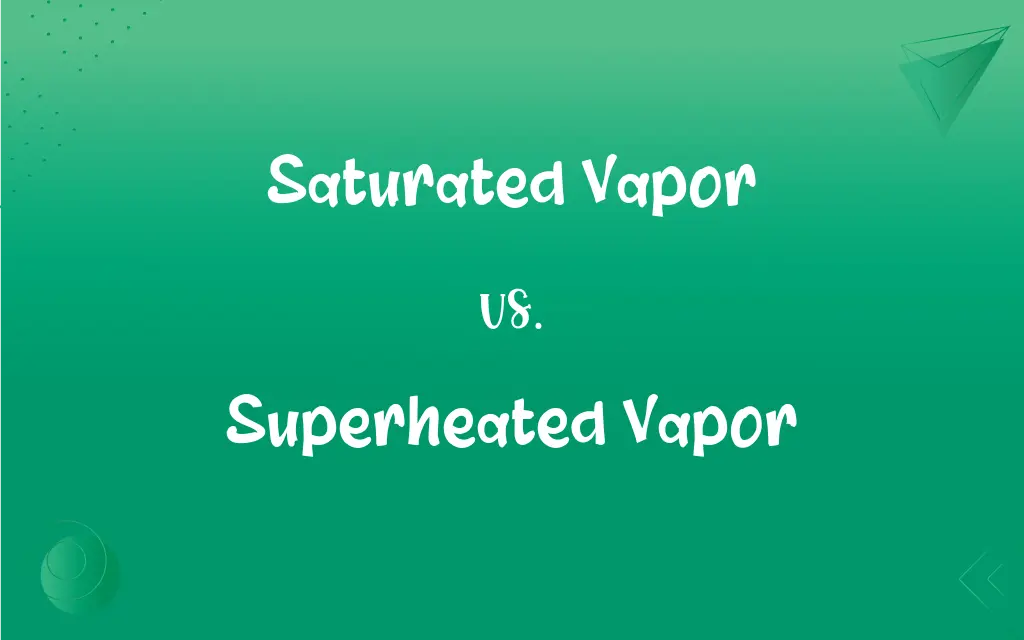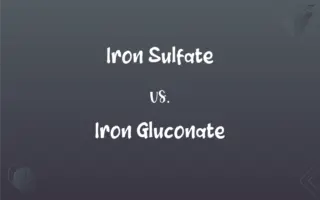Saturated Vapor vs. Superheated Vapor: What's the Difference?
Edited by Harlon Moss || By Janet White || Published on December 25, 2023
Saturated vapor is at equilibrium with its liquid at a given temperature and pressure, whereas superheated vapor is heated beyond its boiling point without condensation.

Key Differences
Saturated vapor exists in a state where it is in equilibrium with its liquid phase at a specific temperature and pressure. In this state, any addition of heat leads to phase change without temperature rise. Superheated vapor, however, is vapor that has been heated above the temperature at which it would be in equilibrium with its liquid phase. It occurs when vapor is heated further after reaching its boiling point, resulting in a vapor that is at a higher temperature than its saturation temperature at the same pressure.
In saturated vapor, the energy content is such that it is on the brink of condensation; any loss of energy (cooling) can lead to condensation. Saturated vapor contains the maximum amount of energy it can without becoming a liquid at that specific pressure. Superheated vapor, conversely, has been provided with additional energy beyond the saturation point. This extra energy means that it can lose some energy without condensing and is not in immediate risk of phase change.
Saturated vapor exists in a delicate balance of pressure, volume, and temperature, where it is ready to condense under the right conditions. This state is typically found right at the boiling point of a substance at a given pressure. In the case of superheated vapor, the vapor has been heated beyond this equilibrium point, meaning it occupies a greater volume at the same pressure compared to its saturated counterpart.
Saturated vapor is often encountered in processes where phase equilibrium is important, such as in steam engines or refrigeration cycles, where the phase change of vapor to liquid is a crucial aspect of the energy transfer process. Superheated vapor is used in processes where it is advantageous to have vapor at a higher temperature without the risk of condensation, such as in turbines in power plants, where superheating the steam increases efficiency.
The concept of saturated vapor is critical in meteorology for understanding cloud formation and precipitation, as it relates to the moisture content of air. Superheated vapor is more relevant in engineering and industrial processes where high-temperature vapors are needed to drive turbines or other mechanical devices without the complications of condensation.
ADVERTISEMENT
Comparison Chart
Temperature Relation
At temperature where it coexists with its liquid phase
Heated beyond its boiling point without condensation
Energy Content
Maximum energy without becoming liquid at specific pressure
Additional energy beyond saturation point
Phase Change Risk
Ready to condense with energy loss
Can lose some energy without condensing
Volume at Same Pressure
Occupies a specific volume per pressure-temperature relation
Occupies a greater volume than saturated vapor at same pressure
Applications
Used in systems requiring phase equilibrium
Used in high-temperature applications without condensation risk
ADVERTISEMENT
Saturated Vapor and Superheated Vapor Definitions
Saturated Vapor
Saturated vapor represents a state of dynamic equilibrium.
Cloud formation involves the transition of water to saturated vapor.
Superheated Vapor
Superheated vapor contains more energy than its saturation point.
Superheated steam is used in turbines for its high energy content.
Saturated Vapor
Saturated vapor is in equilibrium with its liquid phase.
The steam above boiling water is a saturated vapor.
Superheated Vapor
Superheated vapor occupies more volume than its saturated counterpart.
Superheated steam expands more, providing greater force in engines.
Saturated Vapor
Saturated vapor contains the maximum energy before becoming liquid at a specific pressure.
In a steam engine, the steam reaches a saturated vapor state at maximum efficiency.
Superheated Vapor
Superheated vapor maintains a higher temperature than its saturation temperature.
Industrial processes use superheated vapor for consistent high-temperature supply.
Saturated Vapor
Saturated vapor’s state is specific to its pressure and temperature.
The saturated vapor pressure inside a pressure cooker increases with heat.
Superheated Vapor
Superheated vapor has a lower risk of condensing immediately.
Superheated vapor in pipes ensures efficient transport without condensation.
Saturated Vapor
Saturated vapor condenses upon cooling.
Saturated vapor in the air forms dew when it cools.
Superheated Vapor
Superheated vapor is heated beyond its liquid's boiling point.
The steam in a superheater of a power plant is superheated vapor.
FAQs
How does saturated vapor form?
Saturated vapor forms when a liquid is heated to its boiling point at a given pressure.
What is saturated vapor?
Saturated vapor is vapor that is in equilibrium with its liquid at a specific temperature and pressure.
What defines superheated vapor?
Superheated vapor is vapor that has been heated beyond its boiling point, at a given pressure, without undergoing condensation.
What is the significance of superheated vapor in industrial applications?
Superheated vapor is used in industrial applications for its higher energy content and reduced condensation risk.
Is superheated vapor visible?
Superheated vapor is typically not visible, as it is a clear gas, unlike the misty appearance of near-boiling point vapor.
How is saturated vapor related to humidity?
Saturated vapor is closely related to humidity, as it represents the maximum amount of water vapor air can hold at a given temperature.
What happens when saturated vapor cools?
When saturated vapor cools, it condenses back into its liquid form.
Can saturated vapor exist at room temperature?
Yes, saturated vapor can exist at room temperature for substances with low boiling points.
Why is superheated vapor important in power generation?
Superheated vapor is important in power generation because it increases the efficiency of turbines.
Can superheated vapor occur naturally?
Superheated vapor is less common in nature and is typically a result of human-made processes.
Why is superheated vapor used in sterilization?
Superheated vapor is used in sterilization for its high temperature, which effectively kills bacteria and spores.
What is the saturation point in vapor?
The saturation point is the temperature and pressure at which vapor is in equilibrium with its liquid form.
Can superheated vapor transfer heat efficiently?
Yes, superheated vapor is efficient in heat transfer due to its high energy content.
What is the difference in energy content between saturated and superheated vapor?
Superheated vapor has higher energy content than saturated vapor, as it is heated beyond the saturation point.
How does pressure affect superheated vapor?
Increasing pressure can reduce the degree of superheating of a vapor by bringing it closer to its saturation point.
What role does saturated vapor play in weather?
Saturated vapor plays a key role in cloud formation and precipitation in weather systems.
How do you measure the saturation point of vapor?
The saturation point of vapor is measured by its temperature and pressure relationship, often referred to as the saturation curve.
Does saturated vapor cause condensation on surfaces?
Yes, saturated vapor can cause condensation on surfaces if the surfaces are cooler than the saturation temperature.
How do industries create superheated vapor?
Industries create superheated vapor by heating vapor above its boiling point, often using superheaters in steam boilers.
What is a common example of saturated vapor?
A common example of saturated vapor is the steam above a pot of boiling water.
About Author
Written by
Janet WhiteJanet White has been an esteemed writer and blogger for Difference Wiki. Holding a Master's degree in Science and Medical Journalism from the prestigious Boston University, she has consistently demonstrated her expertise and passion for her field. When she's not immersed in her work, Janet relishes her time exercising, delving into a good book, and cherishing moments with friends and family.
Edited by
Harlon MossHarlon is a seasoned quality moderator and accomplished content writer for Difference Wiki. An alumnus of the prestigious University of California, he earned his degree in Computer Science. Leveraging his academic background, Harlon brings a meticulous and informed perspective to his work, ensuring content accuracy and excellence.






































































